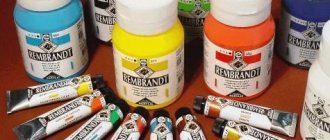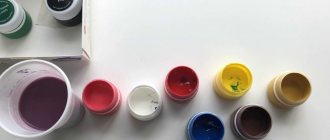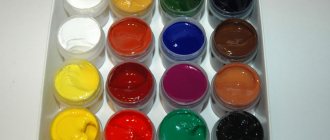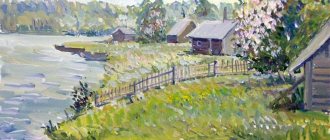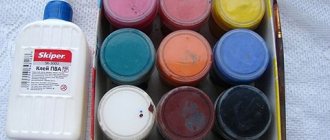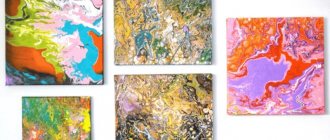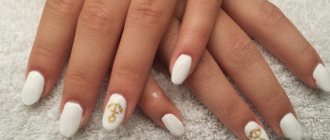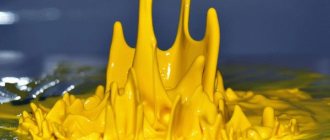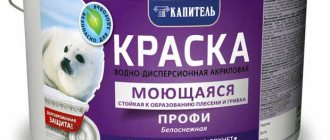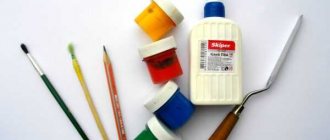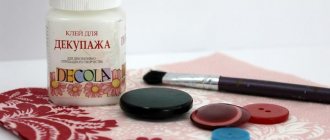In fine arts, different types of paints are used. Often artists make their first works in watercolor and then move on to other techniques. In order not to make a mistake in choosing the next stage of mastering painting, you need to find out how acrylic paints differ from gouache.
Acrylic paints can be used both for painting on paper and for decorating leather, wood or glass.
Difference between gouache and acrylic paint
Both experienced and novice artists care about painting their masterpieces. However, if the former have long ago decided on the choice of optimal paints, then the latter may be somewhat confused. On the one hand, I would like to give preference to bright, thick gouache. However, on the other side of the scale are acrylic paints, which today are extremely popular among creative people. What are the advantages and disadvantages of these materials? Let's try to figure out the difference between gouache and acrylic paint.
Definitions
Gouache is a type of water-soluble adhesive-based paint with a dense matte texture. The product has a rich history, because it was used in medieval Europe. However, the term arose only in the 18th century in France. During the Middle Ages, gouache in combination with watercolor was used to create book miniatures. Renaissance artists used the material to complete sketches and other preparatory work. The heyday of technology occurred at the end of the 19th – beginning of the 20th century. Domestic artists painted theatrical costumes and posters with gouache, created sketches of scenery and large easel works. By the way, the word gouache is translated from French as “water paint”. It is made from adhesive pigments mixed with white. The latter give the paint a spectacular matte velvety finish. Despite the fact that gouache is an independent technique, it is extremely rarely used by professional artists. Many artists consider it suitable only for creating children's drawings and designing posters.
Gouache
Acrylic paint is a water-dispersed paint made on the basis of polyacrylates and their copolymers. It is used both in painting and in construction when carrying out external and internal work. It acts as a worthy alternative to oil paints. It can be applied to paper or planes in liquid (with the addition of water) or paste form. The last option is the most popular among professional artists. Acrylic does not crack, lays down as an even film, is slightly shiny and does not require fixing. Sometimes the paintings he painted resemble works done with watercolors or oil paints. However, in most cases, acrylic has a unique color rendition that is unattainable in other areas of fine art. Largely due to this, he enjoys wide popularity among contemporary artists.
Acrylic paints
History[edit]
Otto Rehm invented acrylic resin, which quickly became acrylic paint. As early as 1934, the German chemical company BASF developed the first usable acrylic resin dispersion, which was patented by Rohm and Haas. Synthetic paint was first used in the 1940s, combining some of the properties of oil and watercolor. [4] Between 1946 and 1949, Leonard Beaucourt and Sam Golden invented solution-based acrylic paint under the brand name Magna. These were mineral spirit based paints. [5] Acrylic paints became commercially available in the 1950s.
Golden then developed a water-based acrylic paint called "Aquatec". [6] In 1953, José L. Gutierrez produced Politec Acrylic Artists' Colors
in Mexico, and Henry Levinson of the Permanent Pigments Co. from Cincinnati produced Liquitex paints. These two product lines were the first acrylic emulsion paints for artists. [7]
Water-based acrylic paints were subsequently marketed as latex house paints, since latex is the technical term for a suspension of microparticles of polymer in water. Interior latex house paints are typically a combination of a binder (sometimes acrylic, vinyl, PVC, etc.), filler, pigment, and water. Latex exterior house paints can also be copolymer blends, but the best water-based exterior paints are 100% acrylic due to elasticity and other factors. Vinyl, however, costs half as much as 100% acrylic resins, and polyvinyl acetate (PVA) is even cheaper, so paint companies create many different combinations of them to suit the market. [8]
Soon after water-based acrylic binders were introduced as household paints, artists and companies began exploring the potential of new binders. Water-soluble acrylic paints for artists have been sold commercially by Liquitex since the 1950s, and modern high-viscosity paints became available in the early 60s. In 1963, George Rowney (part of the Daler-Rowney company since 1983) became the first manufacturer to introduce acrylic paints for artists under the brand name "Cryla" in Europe. [3]
Comparison
The first difference lies in the composition of the products we are interested in. Gouache is made with the addition of white. In this regard, the paint after drying becomes significantly lighter and becomes matte. In general, the composition of gouache is similar to watercolor. Whereas water-dispersed acrylic has a structure similar to oil paints. It dries very quickly, which cannot be said about gouache. As long as the paint remains wet, it can be washed off with water without much difficulty. Acrylic is highly resistant, it does not fade in the sun, and does not spread when applying a new layer. With gouache everything is exactly the opposite. But it is much thicker and denser than acrylic paint. Due to the high content of coloring pigments, gouache is characterized by a very saturated color, and the pattern it creates is opaque. Acrylic paints lie on the surface much smoother, as if forming an invisible film on it. After drying they darken a little. Gouache gives a thicker and uneven layer. The transitions from one shade to another are quite abrupt.
Another significant difference between gouache and acrylic paint is the area of use of materials. As a rule, the first is used for drawing on paper of any thickness, and less often for painting fabrics. Acrylic is characterized by a wide range of applications. It is indispensable for painting ceilings, walls and other surfaces on a wooden or metal base. Creating drawings, painting on glass, decorating ceramic products, applying images to fabric and leather, airbrushing - the list of possibilities of acrylic paints is very extensive. This explains the relatively high cost of the material. If gouache is sold exclusively in sets with a certain number of jars in a box, then acrylic paints are often sold individually. They are bottled in a wide variety of bottles, be it miniature tubes of 20 ml or large bottles with the capacity of a standard glass.
Let's summarize what is the difference between gouache and acrylic paint.
Source
Notes and links[edit]
- Here the word describes a technique that allows more time for paint to dry.
- https://www.researchgate.net/publication/274014713_A_preterior_study_of_the_composition_of_commercial_oil_acrylic_and_vinyl_paints_and_their_behaviour_after_accelerated_ageing_conditions
- ^ ab "Art Materials". Daler Rowney. 2012-02-15. Retrieved February 5, 2013.
- Jump up
↑ Phaidon Press (2001).
Book on the art of the twentieth century
(reprinted. Ed.). London: Phaidon Press. ISBN 0714835420. - Terry Fenton online essay on Noland and acrylic paint, accessed April 30, 2007
- "The History of GOLDEN Artist Colors, Inc". Golden Artist Colors, Inc.
- Acrylic Painting (Watson-Guptill Publications)
- "Water-Based Alchemy by Dean Sickler". Archived from the original on August 29, 2012. Retrieved August 11, 2012.
- "How to Modify Acrylic Paint with Materials". My blue stamp
. My blue seal. April 7, 2022. - Sealing, staining and filling [1] Archived August 3, 2010, at the Wayback Machine Wood Finishing and Refinishing, accessed December 8, 2010,
- Medaris Culea, Patti (2005). Creative faces of fabric dolls: use of paints, pastels, fibers, beading, collages
. Career books. paragraph 64. ISBN 159253144X. - Grattage [2] Art Techniques, accessed December 8, 2010.
- Staff, Artists Network (2016-10-11). “2 ways to thin acrylic paint | Drawing with acrylic paints for beginners." Artists Network
. Retrieved February 3, 2022. - "Val Green's Art Space - Acrylic Painting". www.valgreen.com
. Retrieved March 31, 2016. - Removing Acrylic Paint from Leather [3] Instructions December 8, 2010
- ↑
Preparing A Painting Support [4], accessed December 17, 2017. - OPEN Acrylics, Shellac and SID [5], accessed December 17, 2017.
- ↑
Brady, Patti (December 29, 2008).
rethinking acrylic
. Cincinnati, OH: North Light Books. paragraph 16. ISBN 978-1600610134. - ^ ab Kemp, Will (September 22, 2011). "8 Key Differences Between Artist Quality Acrylics and Students". willkempartschool.com/
. Retrieved April 21, 2015. - ^ ab Glover, David Lloyd (2014). Mixing colors in acrylic. Walter Foster Publishing. ISBN 9781600583889. Retrieved November 16, 2015.
- "Acrylic Paint Heavy Body". Liquitex.com/
. Archived from the original on May 19, 2015. Retrieved April 21, 2015. - "Liquid". goldenpaints.com/
. Retrieved April 21, 2015. - Brady, Patti (2008). rethinking acrylic
. Northern Light Books. paragraph 14. ISBN 978-1600610134. - ↑
Walsh, Sarah (August 2018).
Playful Painting: People: Whimsical Designs and Clever Techniques
. Walter Foster Publishing. ISBN 978-1633224698. - Glover, David Lloyd (August 2014). Mixing Colors in Acrylics: Learn to Mix Fresh, Vibrant Colors for Still Life Paintings
. Walter Foster Publishing. paragraph 10. ISBN 978-1600583889. - ↑
Some historical pigments and their replacements, accessed December 18, 2022. - ↑
Prussian Blue Hue (Fluid) as of December 18, 2022. - Viridian Green Hue (Heavy Body) accessed December 18, 2017
- General questions about acrylic paint [6] Technical summary of acrylic paint as of December 06, 2010 Archived January 1, 2011 on the Wayback Machine
- Wendon Blake (1997). Acrylic Painting: The Complete Guide. Courier Corporation. P. 59–. ISBN 978-0-486-29589-3.
- Watercolor vs Acrylic [7], accessed August 21, 2020.
- Appellof, M. E. (1992). Everything you ever wanted to know about watercolor. Watson-Guptill Publications. pp. 399–. ISBN 978-0-823-05649-1.
- Why WaterColor [8] accessed August 21, 2022
Acrylic paints
Acrylic paints for painting are a water-soluble substance that is made from polyesters of acrylic acid. The main advantage of this paint is that its bottom layer will not wash out while applying the top one. This opens up unlimited possibilities for creativity.
Acrylic paints allow you to paint on many materials, including:
Many artists who use acrylic paints note the simplicity and ease of applying them to canvas. These paints are easy to work with, because they are easily soluble in water, applied in an even layer and dry quickly. During the creative process, excess color can be easily corrected and covered up. The resulting pattern will not lose its brightness and color, will not crack or crumble. When the paint dries, it will not be afraid of water or high humidity in the room. On the page https://officetonmarket.by/catalog/kraski-guashevye-49562/ you can find excellent acrylic paints that are suitable just for you.
Gouache: work on a colored background
This option is great for drawings depicting the underwater world, the sky with clouds and birds flying across it. The easiest way to paint winter is with gouache. To do this, snowflake dots, Christmas trees and other objects are applied to blue or blue cardboard. You can use several colors or just one while drawing.
To complete the winter landscape you will only need white gouache. It represents snow, clouds, trees. You should not achieve complete uniform painting of objects with white. Some poorly painted areas add realism to the picture. They play the role of shadows.
Gouache
Gouache is a water-soluble paint that is made on an adhesive base. Thanks to white, it acquires a dense and fairly viscous structure. It is this type of paint that artists usually master after they learn to paint with watercolors.
Gouache is ideal for painting on:
Gouache contains kaolin and white, which allows you to paint fairly dense layers without unwanted streaks. This paint is ideal for painting various paintings.
After applying gouache, the finished drawing has no shine and is soft. When the paint dries, the painting will take on a whitish tint. All paintings that will be painted using gouache must be carefully protected from exposure to moisture and sun, otherwise the drawing will deteriorate.
The main differences between acrylic paint and gouache
Many masters recommend that aspiring artists use gouache to train their skills. But acrylic paints are ideal for professional painters with extensive creative experience. It is worth noting that you can purchase both acrylic paints and gouache at Officeton Market at competitive prices.
The main difference between acrylic is its low viscosity, so this paint is much easier and faster to apply. It dries quite quickly and needs to be constantly diluted with water if the artist prefers to paint slowly. When acrylic paints dry, they become darker, which is not the case with gouache, which, on the contrary, becomes lighter.
Another difference between gouache and acrylic is that gouache is washed away with water, but dried acrylic is unlikely to be washed off. If you mix gouache paint on a palette, it can be reused by adding water. Acrylic will remain dry.
When choosing suitable paints, you need to consider who will use them and for what purposes. This will help you choose the most optimal paint for your creativity and not make a mistake with your choice.
Source
First drawing experiences
It is advisable to offer water-soluble paints to children, as they are harmless. However, there are nuances that can cause inconvenience. These are stained tables, spilled water, merging of parts due to too much liquid on the brush.
It is easier for beginning artists to work with gouache. Children can paint with such paints as early as 2-3 years old. Before starting work, you should explain to your child that the gouache must dry, otherwise it may flow from one part to another and change color. Therefore, you should not paint with paint of a different color next to a still wet part.
Usually, the first work of children is to color objects along the contours drawn on paper. But it is permissible to paint according to the plan directly with brushes.
Acrylic and gouache
Dear colleagues! I would like to hear opinions about these materials.
What is preferable in painting? I mostly paint in watercolors or pastels, but I want to expand my creative field. I have heard that some artists do not consider gouache a material for painting and treat it with disdain. I worked with gouache, and I like this material, but I didn’t have to work with acrylic. Please tell me what are the distinctive properties of these paints, what is more interesting to work with, and what secrets and subtleties of both materials should be known? Thank you very much in advance!
I tried both gouache and acrylic... Acrylic also takes some getting used to. The pigment in it is very concentrated - it seems that you took just a little bit onto the tip of the brush - and when you knead it, the saturation is absolutely eye-popping! Due to this, acrylic is economical. Paints also differ in the degree of coverage - some are denser, others are more transparent. For example, I have 2 white ones - one is our “Ladoga” - it is better to use for glazing, because it has very weak covering power, and one is the Italian Maimeri - dense, thick. The consistency of the paints also takes a while to get used to—a sort of “pasty slipperiness.” Dries quickly. Sometimes even too much.)) But - a definite plus compared to gouache - it’s dried out - you definitely can’t smudge it, even if you fill it with water. well, like this... I worked on paper - there is only one such work in my portfolio, with the firebird... Currently I am painting a wall in my kitchen with acrylic. For the paper I used a brush, and for the wall I used synthetics.
I’m silent about the gouache - I didn’t paint it! I tried to draw using the Brom technique - very interesting!
There is lining, writing and glazing. There are retarders for acrylic up to 1-1.5 hours, but
hiding power decreases. Russian for pastose - ***** (what The pilgrim wrote),
But the glazing works, and through whitewash it’s fine - sort of pastel.
Olga, The pilgrim, Atollan, thank you very much for your comments! very useful information for me
Acrylic dries faster than I can figure out what I need to paint :) The gouache is drying up. That’s why I only use gouache white, acrylic ones are kind of “soapy” in my opinion.
I have acrylic white in a jar - for some reason I like it better than from a tube.
Try a retarder - almost like oil.
By the way, white and black acrylic primers are essentially the same paint.
Yes, it may depend on the manufacturer.
When gouache dries, it usually becomes lighter, while acrylic, on the contrary, darkens.
A dried layer of acrylic is quite difficult to spoil. If you apply new strokes on top of the dried layer, and they do not suit you, then in the near future they can be wiped off even with a rag, dry or damp, without much damage to the lower layer.
As already mentioned, acrylic dries quite quickly, so if you work slowly, it is a good idea to moisten the paint squeezed onto the palette with a little water.
The color mixed on the palette in gouache can be easily used again even after drying; in acrylic you will have to mix it again, as when it dries, it becomes a film that cannot be revived.
Differences between gouache and acrylic paints
In fine arts, different types of paints are used. Often artists make their first works in watercolor and then move on to other techniques. In order not to make a mistake in choosing the next stage of mastering painting, you need to find out how acrylic paints differ from gouache.
Acrylic paints can be used both for painting on paper and for decorating leather, wood or glass.
The use of paints in the technique of the Old Masters
Paint is a powerful and at the same time “capricious” tool, the handling of which requires many years of practice. After all, an unsuccessful brushstroke or one small area missing the color can ruin the entire work. And only exceptional talents can create a “living” picture, relying solely on the power of paint.
But there is another approach to painting, which is based not on intuition and virtuosity in mastering one single instrument, but on a clear system. We are talking about the technique of the Old Masters, as a result of which the image is born as if by itself. Color, volume, texture and smooth tonal transitions appear independently as a result of performing certain work at each stage, and paint is used only at one of the final stages to give the picture saturation and add missing shades. Watercolor is most often used, but other types of paints can be used. But the main thing is that by following the system, you will learn to paint realistic pictures without being a genius and without spending decades mastering the art of working only with paints. You can read more about optical transmission technology, which is based on the technique of the Old Masters, in the book available for download at this link.
Features of acrylic paints
Acrylic paints are a water-soluble substance based on polyesters of acrylic acid. Their main advantage is that the bottom layer does not erode or flow when applying the top one.
They make it possible to create drawings on various surfaces:
Acrylic paints are easily applied to the canvas, covering it evenly with a thin layer. They are easy to work with because they dissolve well in water and dry quickly. Defects can be easily corrected if you quickly remove excess color or strokes that go beyond the scope of the drawing.
Due to its structure, acrylic offers the artist various options for textures, shades and techniques. With it you can create voluminous sharp strokes or smooth watercolor transitions.
It does not change color over time, does not crack or fall off the surface. After drying, the acrylic drawing is not afraid of exposure to water.
Characteristics of gouache
Gouache is a water-soluble adhesive-based paint. It has a dense and matte structure due to the white in its composition. Often gouache becomes the second coating that an artist masters after watercolor.
Gouache is a water-soluble paint with a dense structure.
It is intended for coloring the following materials:
The kaolin and white contained in the paint allow you to create dense layers without streaks or blurring of the base. With its help you can paint pictures in various techniques: watercolors, glazes, brush strokes. Errors can be easily corrected by using an additional layer: in this case, it is permissible to apply a lighter color to a dark one.
The finished coating has no shine, which makes the pattern soft and velvety. After drying, the painting takes on a whitish tint. The composition is prone to cracking with an impasto style of writing. Paintings painted in gouache must be protected from moisture, dust and direct sunlight.
At first, a novice artist should learn to work with gouache, since it takes longer to dry and dissolves in water even after drying.
Watercolor
Watercolor is produced in different forms: in ready-made palettes, in tubes and in liquids. To paint with watercolors, you need watercolor or cotton paper, brushes, and clean water. Watercolor is a water-activated paint. Therefore, the color saturation on the paper will depend on the amount of water you put on the brush. This type of paint is characterized by transparency, so rather than covering the paper with it, you leave a colored “trace” on it. Thanks to this property, various techniques are used when working with watercolors, for example, gradients, layering colors, etc. The most important thing when working with watercolors is time, since after the paint dries on paper, you may not get the result you expected. If you need to achieve uniform coverage of the paper with color, you should first go over the desired area of the drawing with a wet brush without paint, while distributing the water evenly over the paper. Otherwise, you cannot avoid unwanted texture and accumulation/lack of pigment in different parts of the drawing, sharp lines. When working with watercolors, it is important to remember that color density must be achieved in layers, that is, from light to dark.
Tip: When working with watercolors, you can mix in white gouache to make the color pastel.
What is the difference between gouache and acrylic
Beginning artists are recommended to first master the technique of painting with gouache and only after that move on to acrylic paints, which are a tool for the work of professionals. The difference between these two compositions lies in several parameters.
Acrylic is less viscous, dense and easier to apply to the canvas. But it dries quickly and requires dilution with water at low speed. The pigment in it is more concentrated, which reduces material consumption. After drying, acrylic paints darken, while gouache takes on a lighter shade.
Another difference between acrylic and gouache is that it is not subsequently washed away by water. Dried acrylic paint cannot be washed off from the canvas, brushes, or palette. The gouache material mixed on the palette can be reused if you add water to it . This technique does not work with acrylic.
How the process works
To begin, put PVA glue into the recess in the palette and mix it with gouache. The optimal ratio is 1:1 or 1:2, but to obtain the desired consistency it is advisable to try different proportions. To create a new tone, we first dilute the paints until a completely satisfactory shade appears and only then add glue. This is due to the lighter color effect before drying.
Painting the figurine with gouache and PVA paint
Carefully scoop up the finished paint with a brush and apply it to the prepared material. To fix the finished pattern, it is coated with an additional layer of PVA glue or varnish. In this case, it will no longer be possible to wash off the image and reuse the canvas.
Gouache based on PVA glue is a very effective and affordable paint for creativity, which is easy to make yourself. It is suitable for painting a wide variety of surfaces.
Is it possible to mix acrylic paints with gouache?
Acrylic and gouache can be mixed, since both compositions are water-soluble. If you don’t have a color scheme at hand, then combining these materials is a good way to achieve the desired shade. Ready-made acrylic gouache can be purchased at artist stores.
It has the following advantages:
The drawing, made in acrylic with the addition of gouache, is distinguished by its pure tones, brightness and expressiveness. The picture can be stored without additional protection, since the coating, after drying, does not fade in the sun, does not crack or peel off.
Source
Watercolor paint
Most of us have a lot of experience with watercolor paints, as we all used them as children. Stop by your local dollar store and get a pallet for 99 cents!
This is really cool considering watercolor has been used for centuries (think Egyptian times) and now you'll see entire preschool classes creating their own little masterpieces with watercolor paint.
Watercolor paint is inexpensive but can produce a beautiful end result. It dries quickly, is almost transparent and has a matte finish. Artists can layer watercolor paint because of its translucency to create a more vibrant image.
However, watercolor paints require a special type of paper as the base is water, so it is important that the paper does not absorb moisture. Watercolor can easily bleed through something like printer paper because it is very absorbent.
A silly but great example of letting your child use watercolors on the pages of a coloring book. The moment the brush touches the page, the color will disappear and there will be almost no color showing on the page.
On the other hand, as an artist you control the color outcome when painting with watercolors. If you add more water, the color will become almost translucent. If you use a small amount of water, the color will be deeper.
Imagine this:
You've completed your watercolor masterpiece and a single drop of water has landed on the page. Instantly your work changes.
Watercolors may be cheap to buy and seem like one of the easiest types of paint to use, but they can actually be difficult to master. Finding the perfect ratio of water to paint takes some work and effort. It is also much more difficult to hide a mistake when using watercolor paint due to its opacity.
Acrylic paint
Unlike gouache and watercolor paints, acrylic paints are more forgiving because they have a deeper and thicker base, as opposed to translucent and more water-based paints. Acrylic paint is used by artists who are willing to work quickly and carefully.
Acrylic paint is more durable than gouache or watercolor in the sense that it does not fade as quickly when exposed to light, they can resist dust and they are waterproof. Paintings painted with acrylic paint will be much brighter than those painted with watercolors. Acrylic paints can be used with little to no water to create a thicker, more dramatic brush stroke.
Acrylic can be used on a variety of surfaces such as paper, wood, glass, plastic, the list goes on. Watercolor can really only be used properly on paper. Basically, you can paint with acrylic paint in tow on anything.
With acrylic, you can create clearer paintings and working lines, and even draw letters if necessary. You don't have this advantage when using watercolor. You also have the option of using other tools when working with acrylic, such as a palette knife, whereas this is not an option with gouache and watercolor paint.
So what's the problem?
Well, acrylic dries very quickly, which can be good or bad depending on the artist doing the painting. Another disadvantage of acrylic paint is that you cannot redo acrylic paint if it looks exactly like gouache paint. Acrylic is also slightly more expensive than its cousins, gouache and watercolor.
To sum up the comparison between gauze, watercolor and acrylic As an artist, you need to understand what works best for you. While one artist might like the idea of restoring their painting after 10 years because they used gouache paint, another artist might prefer their painting to be frozen in time, knowing that it will remain the way they left it for many years. come.
Although gouache, watercolor and acrylic paint may have their differences, they are all capable of creating a beautiful masterpiece.
Source
What is the best way to draw pictures?
For smooth thin layer painting (depending on size) best
Fine or medium grain canvas is suitable. For textured, impasto (applied with thick paint) painting there should be a thicker and stronger base - a coarse-grained canvas is good here.
Interesting materials:
What is the name of the person who stands behind the counter in a hotel? What is the name of a person who studies in a master's program? What is the name of the person who flies a hot air balloon? What do you call a person who takes everything to heart? What is the name of the person who meets you at the hotel? What do you call a person who has no sense of smell? What do you call a person who has no opinion? What is the name of a person who has a split personality? What is the name of a person who has both hands? What do you call a person for whom everything must be perfect?
